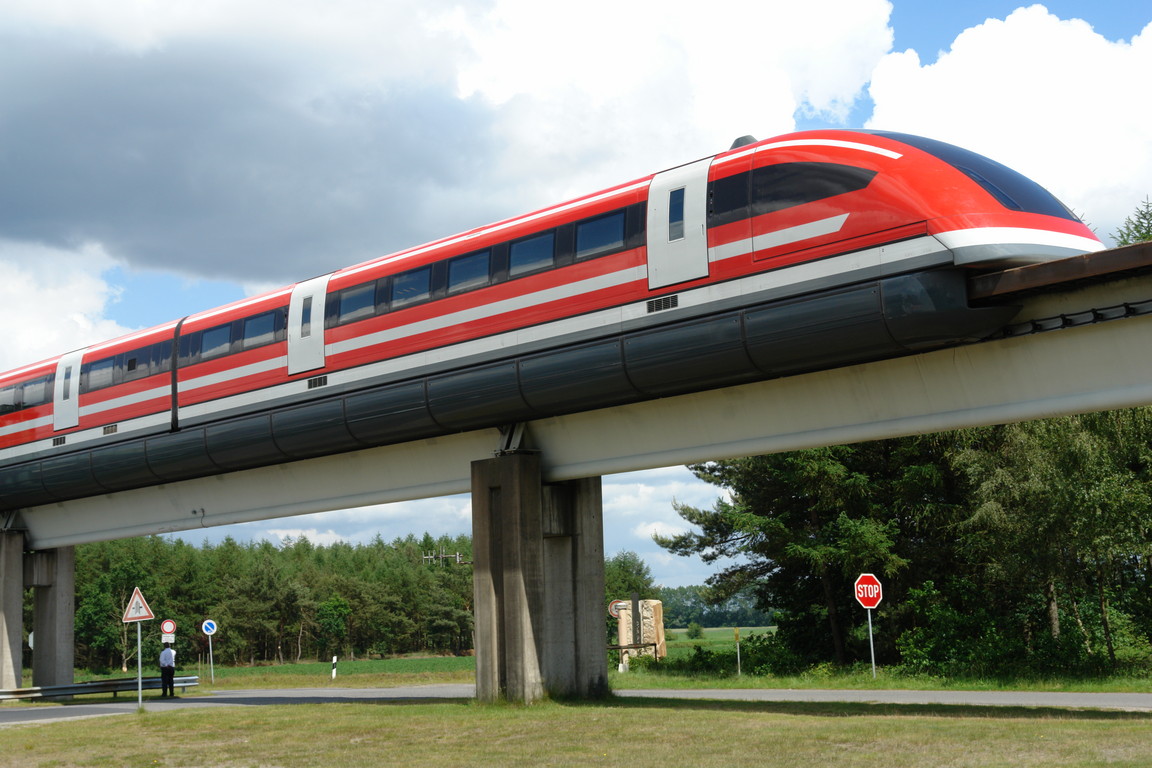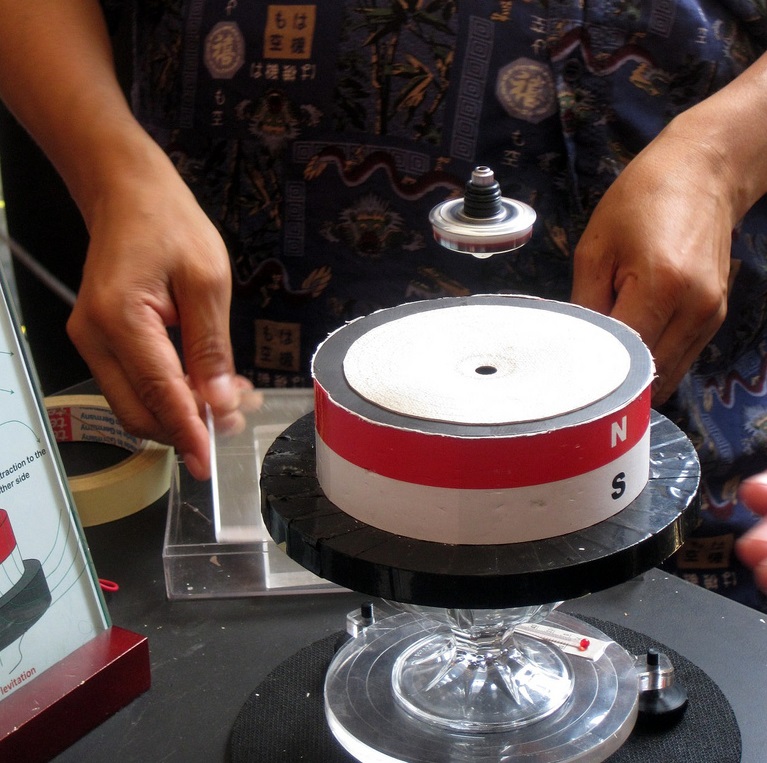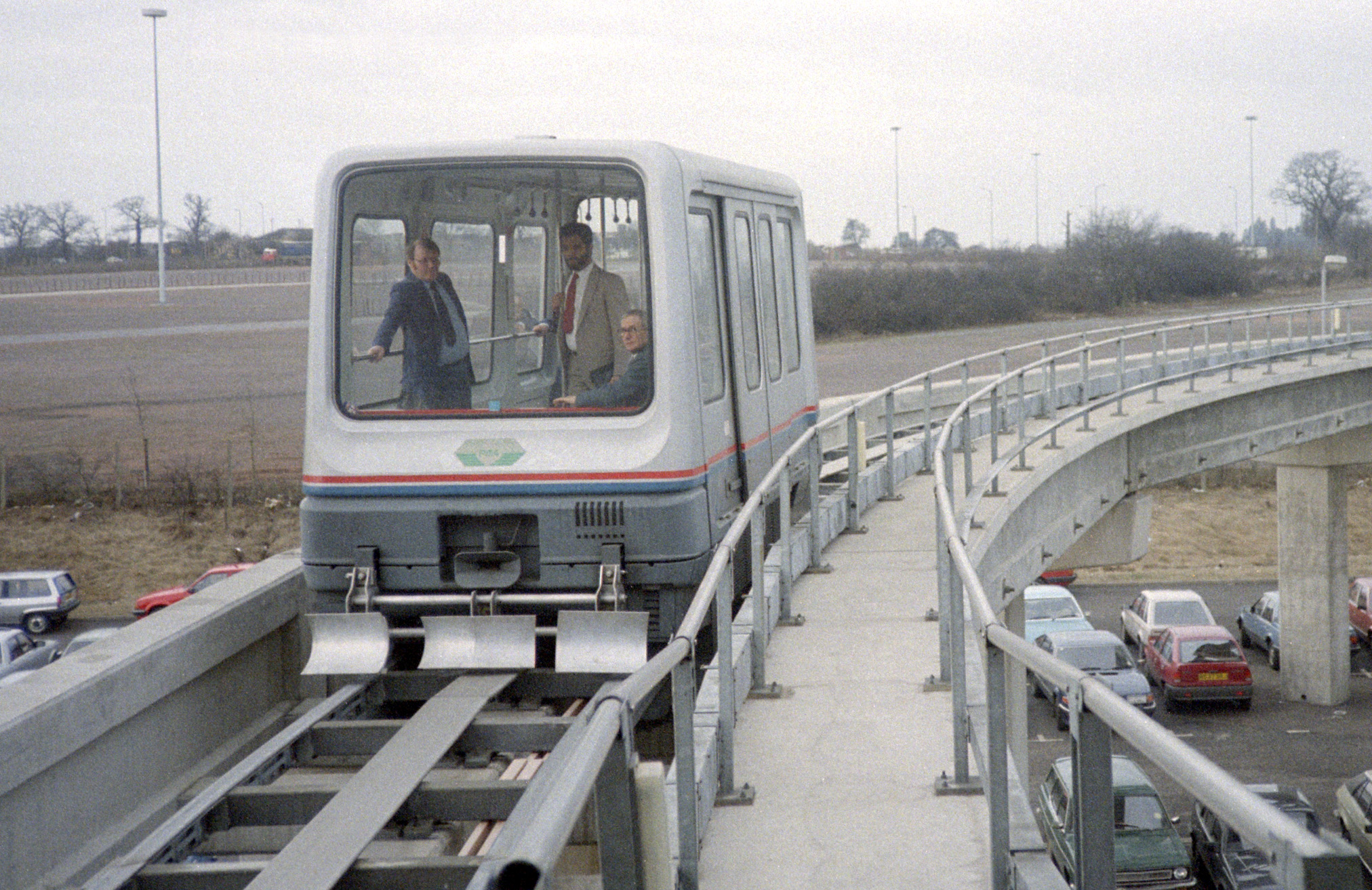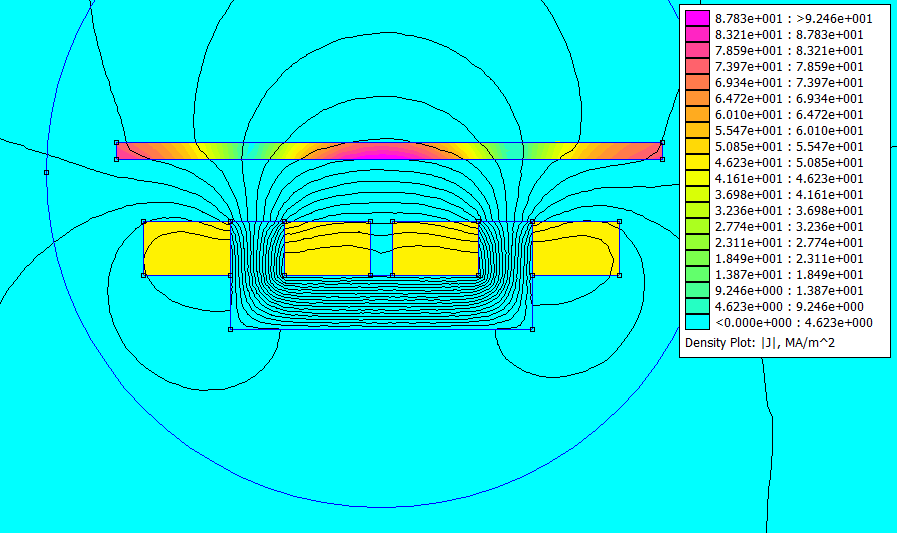|
Maglev
Maglev (derived from '' magnetic levitation''), is a system of train transportation that uses two sets of electromagnets: one set to repel and push the train up off the track, and another set to move the elevated train ahead, taking advantage of the lack of friction. Such trains rise approximately off the track. There are both high speed, intercity maglev systems (over ), and low speed, urban maglev systems ( to ) being built and under construction and development. With maglev technology, the train travels along a guideway of electromagnets which control the train's stability and speed. While the propulsion and levitation require no moving parts, the bogies can move in relation to the main body of the vehicle and some technologies require support by retractable wheels at low speeds under . This compares with electric multiple units that may have several dozen parts per bogie. Maglev trains can therefore in some cases be quieter and smoother than conventional trains and have t ... [...More Info...] [...Related Items...] OR: [Wikipedia] [Google] [Baidu] |
Transrapid Shanghai Maglev Train Ride
Transrapid is a German-developed High-speed rail, high-speed monorail, monorail train using Maglev, magnetic levitation. Planning for the Transrapid system started in 1969 with Emsland test facility, a test facility for the system in Emsland, Germany completed in 1987. In 1991, technical readiness for application was approved by the Deutsche Bundesbahn in cooperation with renowned universities. The last version, the Transrapid 09, is designed for a cruising speed of and allows acceleration and deceleration of approximately . In 2002, the first commercial implementation was completed – the Shanghai Maglev Train, which connects the city of Shanghai's rapid transit network to Shanghai Pudong International Airport. The Transrapid system has not yet been deployed on a long-distance intercity line. The system is developed and marketed by Transrapid International, a joint venture of Siemens and ThyssenKrupp. In 2011, the Emsland test track closed down when its operatin ... [...More Info...] [...Related Items...] OR: [Wikipedia] [Google] [Baidu] |
Magnetic Levitation
Magnetic levitation (maglev) or magnetic suspension is a method by which an object is suspended with no support other than magnetic fields. Magnetic force is used to counteract the effects of the gravitational force and any other forces. The two primary issues involved in magnetic levitation are ''lifting forces'': providing an upward force sufficient to counteract gravity, and ''stability'': ensuring that the system does not spontaneously slide or flip into a configuration where the lift is neutralized. Magnetic levitation is used for maglev trains, contactless melting, magnetic bearings and for product display purposes. Lift Magnetic materials and systems are able to attract or repel each other with a force dependent on the magnetic field and the area of the magnets. For example, the simplest example of lift would be a simple dipole magnet positioned in the magnetic fields of another dipole magnet, oriented with like poles facing each other, so that the force between mag ... [...More Info...] [...Related Items...] OR: [Wikipedia] [Google] [Baidu] |
Train
In rail transport, a train (from Old French , from Latin , "to pull, to draw") is a series of connected vehicles that run along a railway track and Passenger train, transport people or Rail freight transport, freight. Trains are typically pulled or pushed by locomotives (often known simply as "engines"), though some are self-propelled, such as multiple units. Passengers and cargo are carried in railroad cars, also known as wagons. Trains are designed to a certain Track gauge, gauge, or distance between rails. Most trains operate on steel tracks with steel wheels, the low friction of which makes them more efficient than other forms of transport. Trains have their roots in wagonways, which used railway tracks and were Horsecar, powered by horses or Cable railway, pulled by cables. Following the invention of the steam locomotive in the United Kingdom in 1804, trains rapidly spread around the world, allowing freight and passengers to move over land faster and cheaper than ever pos ... [...More Info...] [...Related Items...] OR: [Wikipedia] [Google] [Baidu] |
Birmingham Airport, West Midlands
Birmingham Airport , formerly ''Birmingham International Airport'', is an international airport located east-southeast of Birmingham city centre, west-northwest of Coventry slightly north of Bickenhill village, in the Metropolitan Borough of Solihull, England. Officially opened as ''Elmdon Airport'' on 8 July 1939, the airport was requisitioned by the Air Ministry during Second World War and used by both the Royal Air Force (RAF) and the Royal Navy as ''RAF Elmdon''. It was largely used for flight training and wartime production purposes. On 8 July 1946, the aerodrome was reopened to civilian operations. Birmingham Airport currently holds a CAA Public Use Aerodrome Licence (Number P451) that allows flights for the public transport of passengers or for flying instruction. Passenger throughput in 2017 was over 12.9 million, making Birmingham the seventh busiest airport in the UK. The airport offers international flights to destinations in Europe, the Middle East, the I ... [...More Info...] [...Related Items...] OR: [Wikipedia] [Google] [Baidu] |
AirRail Link
The Air-Rail Link is a people mover linking Birmingham Airport with Birmingham International railway station and the National Exhibition Centre in England. The current system, originally known as SkyRail, replaced the earlier Birmingham Maglev system in 2003. The current system is a fully automated cable-hauled system that opened in 2003 and has a length of . It takes passengers between the high-level railway station concourse and the airport terminal buildings. It is free to use, and handles three million passengers per year. The Birmingham Maglev was opened in 1984 and was the first commercial Maglev transport system in the world. It operated up until 1995. The system was fully automated and used an elevated concrete guideway, much of which has been reused for the current Air-Rail Link system. Maglev Initial feasibility studies for a link from the airport to the railway station and exhibition centre were started in 1979 by the owners of the airport at that time, West Midl ... [...More Info...] [...Related Items...] OR: [Wikipedia] [Google] [Baidu] |
Tracked Hovercraft
Tracked Hovercraft was an experimental high speed train developed in the United Kingdom during the 1960s. It combined two British inventions, the hovercraft and linear induction motor, in an effort to produce a train system that would provide inter-city service with lowered capital costs compared to other high-speed solutions. Substantially similar to the French Aérotrain and other hovertrain systems of the 1960s, Tracked Hovercraft suffered a similar fate to these projects when it was cancelled as a part of wide budget cuts in 1973. History Genesis at Hovercraft Development It was noticed early on in the development of the hovercraft that the energy needed to lift a vehicle was directly related to the smoothness of the surface on which it travelled. This was not entirely surprising; the air trapped under the hovercraft will remain there except where it leaks out where the lifting surface contacts the ground — if this interface is smooth, the amount of leaked air will b ... [...More Info...] [...Related Items...] OR: [Wikipedia] [Google] [Baidu] |
Shanghai
Shanghai (; , , Standard Mandarin pronunciation: ) is one of the four direct-administered municipalities of the People's Republic of China (PRC). The city is located on the southern estuary of the Yangtze River, with the Huangpu River flowing through it. With a population of 24.89 million as of 2021, Shanghai is the most populous urban area in China with 39,300,000 inhabitants living in the Shanghai metropolitan area, the second most populous city proper in the world (after Chongqing) and the only city in East Asia with a GDP greater than its corresponding capital. Shanghai ranks second among the administrative divisions of Mainland China in human development index (after Beijing). As of 2018, the Greater Shanghai metropolitan area was estimated to produce a gross metropolitan product (nominal) of nearly 9.1 trillion RMB ($1.33 trillion), exceeding that of Mexico with GDP of $1.22 trillion, the 15th largest in the world. Shanghai is one of the world's major centers for ... [...More Info...] [...Related Items...] OR: [Wikipedia] [Google] [Baidu] |
Railway Speed Record
The world record for a conventional wheeled passenger train is held by France's TGV (''Train à Grande Vitesse''), set in 2007 when it reached on a section of track. Japan's experimental maglev train L0 Series achieved on a 42.8 km magnetic levitation track in 2015. World speed records Legend: ; Arr (Arrangement) : Disposition and number of elements forming the train. :; Loc:One locomotive pulling one or more cars) :; Multi :Multi Motorized Elements :; Single :Single rail vehicle ; Power: DC, DC 3rd rail, AC, Single phase, Triphase, Diesel-elec., Gas, Steam, Diesel-hydraulic, Propeller, Rocket, Jet. ; State: "Proto." (Prototype), "Unmod." (Unmodified from vehicles in service), "unknown" (Unknown), "Tuned" All passenger trains The following is a partial list of absolute world speed records for all trains designed to carry passengers, regardless of gauge, propulsion or type of rail, , - , , , , 1938-20-07 , , Bologna-Milano line between Pontenure and Piacenza , ... [...More Info...] [...Related Items...] OR: [Wikipedia] [Google] [Baidu] |
Vactrain
A vactrain (or vacuum tube train) is a proposed design for very-high-speed rail transportation. It is a maglev (magnetic levitation) line using partly evacuated tubes or tunnels. Reduced air resistance could permit vactrains to travel at very high (hypersonic) speeds with relatively little power—up to . This is 5–6 times the speed of sound in Earth's atmosphere at sea level. 18th century In 1799, George Medhurst of London conceived of and patented an atmospheric railway that could convey people or cargo through pressurized or evacuated tubes. The early atmospheric railways and pneumatic tube transport systems (such as the Dalkey Atmospheric Railway) relied on steam power for propulsion. 19th century In 1888, Michel Verne, son of Jules Verne, imagined a submarine pneumatic tube transport system that could propel a passenger capsule at speeds up to under the Atlantic Ocean (a transatlantic tunnel) in a short story called "An Express of the Future". 20th century The vactrai ... [...More Info...] [...Related Items...] OR: [Wikipedia] [Google] [Baidu] |
Magnetic River
Magnetic river is an electrodynamic magnetic levitation (maglev) system designed by Fredrick Eastham and Eric Laithwaite in 1974. It consists of a thin conductive plate on an AC linear induction motor. Due to the transverse flux and the geometry, this gives it lift, stability and propulsion as well as being relatively efficient. The name refers to the action that provides stability along the longitudinal axis, which acts similar to the flow of water in a river. Linear motors A linear induction motor (LIM) is essentially a conventional induction motor with its primary "unwound" and laid out flat. The rotor, normally consisting of a series of conductors wound onto a form of some sort, is replaced by a sheet of magnetically susceptible metal. Due to its good conductance to weight ratio, aluminium is almost always used for this "stator plate". When the primaries are fed current, they induce a magnetic field in the stator plate, which generates forces away from the plate and along it. ... [...More Info...] [...Related Items...] OR: [Wikipedia] [Google] [Baidu] |
Linear Motor
A linear motor is an electric motor that has had its stator and rotor "unrolled", thus, instead of producing a torque (rotation), it produces a linear force along its length. However, linear motors are not necessarily straight. Characteristically, a linear motor's active section has ends, whereas more conventional motors are arranged as a continuous loop. A typical mode of operation is as a Lorentz-type actuator, in which the applied force is linearly proportional to the current and the magnetic field (\vec F = I \vec L \times \vec B). Linear motors are by far most commonly found in high accuracy engineering applications. It is a thriving field of applied research with dedicated scientific conferences and engineering text books. Many designs have been put forward for linear motors, falling into two major categories, low-acceleration and high-acceleration linear motors. Low-acceleration linear motors are suitable for maglev trains and other ground-based transportation applicat ... [...More Info...] [...Related Items...] OR: [Wikipedia] [Google] [Baidu] |
Tokaido Shinkansen
The is a Japanese high-speed rail line that is part of the nationwide Shinkansen network. Along with the Sanyo Shinkansen, it forms a continuous high-speed railway through the Taiheiyō Belt, also known as the Tokaido corridor. Opened in 1964, running between Tokyo and Shin-Ōsaka, it is Japan's first high-speed rail line. Along with being the world's oldest high-speed rail line, it is also one of the most heavily used. Since 1987 it has been operated by the Central Japan Railway Company (JR Central), prior to that by Japanese National Railways (JNR). It is also called the Kyoto Express due to other previous services for this high-speed train and operating from Tokyo to Kyoto. There are three types of services on the line: from fastest to slowest, they are the limited-stop '' Nozomi'', the semi-fast ''Hikari'', and the all-stop '' Kodama''. Many ''Nozomi'' and ''Hikari'' trains continue onward to the San'yō Shinkansen, going as far as Fukuoka's Hakata Station. The line was ... [...More Info...] [...Related Items...] OR: [Wikipedia] [Google] [Baidu] |


.jpg)






